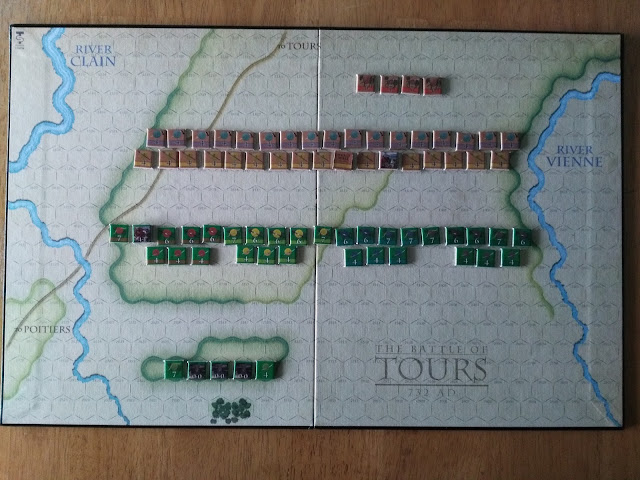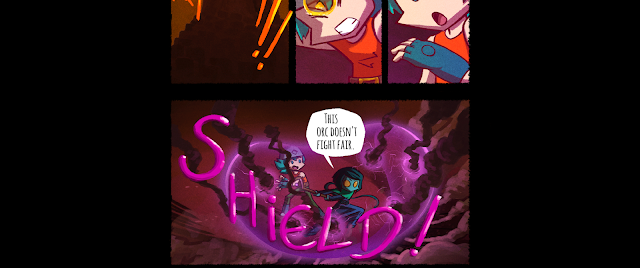GLOOM OF KILFORTH
In terms of narrative and theme, it is difficult for any treatment to be original. In some form or other, it's going to involve questers journeying through a fantasy world, encountering strange creatures, gaining skills, powers and artefacts usually in order to attain some final goal. In that respect, Gloom [for short] perhaps inevitably can be little different.
For many designs and designers, it is the underground route that is taken; the route of trolls and orcs, goblins and the undead through dark and noisome passages and echoing vaults with treasure chests and pitfalls, traps and poisoned stakes, locked and unlocked doors. The tendency of these examples of the genre is for them to be played out on game boards or large tiles that are drawn and laid down to form ever changing locations. They are usually handsomely fleshed out with miniatures, structures and furnishings. They are mainly designed for cooperative play, often against one member of a gaming group who takes on the role of dungeon master, who either plays a neutral role overseeing all the action and die rolls or in a more aggressive role as the Evil One. For some groups this can be a stumbling block when there are few players or simply because everyone wants to be an exploring Hero!
For many gamers, part of the pleasure of these games is the painting of the plastic and the tactile and visual appeal. Cards may play some part, but rarely a major one. Where cards do dominate, it tends to be in the more confrontational games set in fantasy/sci-fi worlds; probably the best known and earliest is Magic: The Gathering and its infinite new decks. This flourishing and major sub-sector; LCGs [Living Card Games]has seen a huge expansion in recent years, often driven by derivations from cult classics, from the cross-fertilised worlds of literature and graphic novels, film and T.V. such as Lord of The Rings and Game of Thrones, or Arkham Horror and Android: Netrunner [itself spawned from the original board game Android, with its loose connection to the work of Robert Heinlein].
"O, what can ail thee, knight-at-arms,
Alone and palely loitering?"
The result is a consummately consistent vision for this fantasy world, whose backstory is outlined on the back of the box.
A game begins with the following three steps -all of which can be done by random draw or personal choice: [1] select one of four quests [2] select a Race for their Hero [3] select a Class. If more than one person is playing, then each follows the same process separately. Your Hero is represented by a cardboard standee according to the Race you have chosen - a good touch is that each one has a male/female side.
Your game board is a five x five landscape of cards - the eponymous Kilforth that will slowly succumb day by day to the GLOOM part of the title. As night falls on the land one more of its locations will fall into not just the ordinary darkness at the end of a day, but the everlasting darkness of evil. This is signified by turning over the randomly selected location card, thus providing a neat and handy game timer too. When all 25 locations have fallen to the Gloom, you've lost!
In the very middle is Sprawl City, where your chosen Hero [or Heroes] will begin the quest.
Though each location is individually named - in the photo above you can just see the edge of the Blessed Grove and the Grand Plains - the terrain types are limited to four: Plains, Mountains, Forest and Badlands.
Finally, there is the Night Deck, one of which will be revealed at the end of each day turn. These contain information as to which location is turned to its Gloom side and usually brings with it some further hindrance for your Heroes!
Among all the many cards, the single significant problem has been with the Location cards in distinguishing the starting side from its reverse when it has been flipped to show that it is now in Gloom. The response from Tristan Hall has been absolutely typical of all his attention to and concern for players of this game. In the soon to be released 2nd edition, this has been addressed through constant dialogue with the gaming community both online and off and ultimately via a democratic vote on the varying ideas of improvement suggested by those gamers.
Along with the cards come a substantial number of cardboard tokens, 142 in all, that make up the Gold and Loot that may come your way when an Encounter is successfully won.
As always, binding all the components together and creating harmony out of the many pieces is the rule book. Like everything else in this game, it is a lavish, quality production of 32 glossy A4 pages in full colour. Besides reproductions of the cards to help illustrate the explanations of how to use them and what the various symbols mean, there are many additional illustrations there purely to maintain the immersive atmosphere of the game.
For a game that works almost entirely with cards, it's no surprise that five pages alone are taken up with explaining them. Be careful how you approach this learning process. I would suggest that a skim through is best without trying to memorise details will pay dividends.
Briefly the rule book takes you through
[1] Set Up
[2] Card Anatomy [i.e. the explanations mentioned above]
[3] Actions - the various things you can do and how to do them, each of which costs an Action Point
[4] Deeds - these are supplements to your Actions, often granted by cards or items that you've acquired and most importantly they do not cost Action points.
[5] The Night Phase
[6] Four separate sections that act as very substantial reference material.
Central to play is the Confront Action as this is the main way in which you will garner the necessary gold, loot, assets and cards to accomplish the Sagas and finally take on and hopefully defeat the Ancient One. As with most fantasy games, this involves tests where your Hero chooses one of their abilities to pit against the ability/quality of what you have encountered. As you might expect encountering enemies is usually the toughest nut to crack.
The hope is that you will be able to test using your strongest ability, but that ability may not necessarily be possessed by your target and so you're forced into using one of your lesser abilities. Even when this does work in your favour, things do not always go to plan, as when I encountered a weak enemy who needed multiple hits on his health to be overcome!
The other major concept is Keywords, as the completion of each Saga entails a set of keywords to be acquired. When winning an encounter, the card you have overcome will contain one or more keywords that can be immediately traded in for a reward or the card can be kept to help you later complete the current Saga. This is one of the more agonising choices you will frequently face: an immediate benefit set against a long-term essential goal.
Sometimes the current situation will pressingly influence your decision, but too often it doesn't. As you gain insight through playing the game, you will learn which locations are most likely to generate certain types of Keyword. If you wish, you can learn these directly from the rules and this certainly will help your progress. But I must confess that I couldn't resist ignoring that readily available knowledge, so that the experience became much more [for me] genuine and engaging as I truly discovered the nature of this realm of Kilforth.
Set up is very quick and there is no myriad outpouring of plastic pieces to be sorted and later stored - never mind their plaintive waiting to be painted. As indicated it is the solitaire experience I have found most valuable, especially as it greatly enhances the feeling of exploring and being in a fantasy world.
As mentioned, a 2nd edition will soon be available and for those of you in need of a French edition, these can be bought direct from Nuts Publishing. Also soon to appear is Tristan Hall's 2nd game Tears To Many Mothers on the topic of The Battle of Hastings.
So, plenty of goodies to get your hands on!


























Follow Us